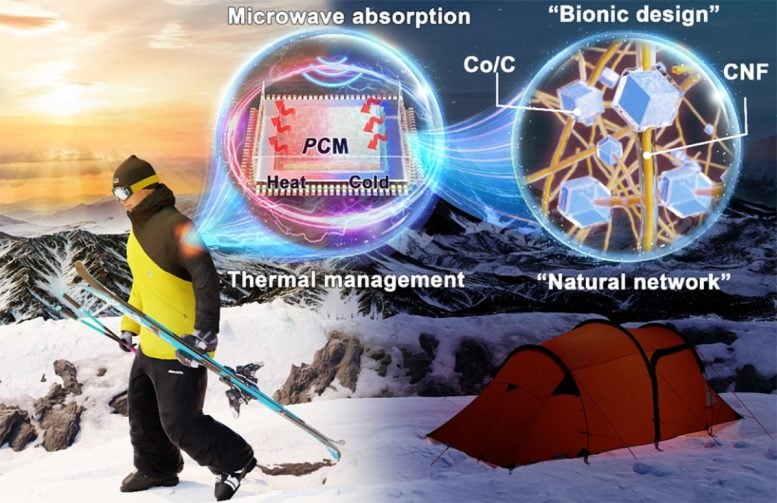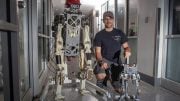
As a result of the bionic design of the neural network-like aerogel-based composite PCMs, both microwave absorption and thermal management are increased, and in colder climates the solar-thermal conversion can be used to heat devices for normal start-up and keep the device closer to an optimal performance temperature. Credit: Beijing Normal University and University of Science and Technology Beijing
Researchers at Beijing Normal University have developed an advanced shielding material for electronic devices that enhances thermal management, solar-thermal conversion, and microwave absorption, showing promise in improving performance and safety in complex electronics.
As electronic devices evolve, they are designed to perform a growing array of functions, which is evident in everyday items like phones, tablets, and watches, as well as in industrial devices. However, this increased complexity can cause performance and safety concerns. Issues such as device overheating or microwave emissions can not only pose health risks but also diminish performance and disrupt the functioning of other devices.
Chinese scientists from Beijing Normal University have been working on building shielding for electronic devices using multifunctional composite phase change materials (PCMs) to address these performance issues. PCMs are man-made materials built by combining different types of elements, allowing the creation of a new material with very specific purpose-driven characteristics. In this case, the researchers are looking to improve thermal management, solar-thermal conversion, and microwave absorption in the electronic devices.
Using engineering inspired by biological systems, a bionic design, they built a neural network-inspired aerogel that increases the efficiency of thermal management and the absorption of microwave emissions.
Research Findings and Applications
“Our developed functionally integrated composite PCMs provide a prospective application of highly integrated and miniaturized electronic devices in complex and changeable outdoor environments,” said Xiao Chen, a researcher from the Institute of Advanced Materials, Beijing Normal University, China.
This research was published on April 3 in Nano Energy Research.
To ensure it had the necessary properties—improved thermal management which optimizes heat dissipation and heat storage, solar-thermal conversion which allows devices to heat up for normal start-up in cold environments, and microwave absorption—the researchers very carefully chose the elements that would be incorporated into their new aerogel shield. Given the space limitations, they could not layer the different materials, so they needed to create a new composite material with all the necessary properties.
Material Composition and Characteristics
The researchers knew that “thermally enhanced PCMs have the ability to store and release massive energy as latent heat, they are widely acknowledged for the ability to ensure precise temperature control,” said Yang Li, first author on the paper and researcher at the Institute of Advanced Materials, Beijing Normal University, Beijing, China. These composites can undergo phase change as the temperature increases from solid to liquid, which increases the available heat storage, and when the temperature cools the liquid reverts to solid. However, while pure PCMs do not show promise in solar-thermal conversion, “bacterial cellulose (BC) is a highly desirable natural biomass due to its numerous advantages including biodegradability, low cost, high purity, renewability, easy modification, and functionalization. BC-derived carbon nanofiber through high-temperature carbonization has been considered as a promising solar-thermal material.”
Another element would be used to address the issue of microwave emissions. “Recent interest in microwave absorption has focused on metal-organic frameworks due to their exceptional porosity, adjustable pore structure, and high specific surface area,” said Ge Wang, from the School of Materials Science and Engineering, University of Science and Technology Beijing, China. “Numerous studies have demonstrated that a porous network structure not only provides large specific surface area for absorbing PCMs, but also dissipates microwave energy through scattering or multiple reflections.”
Finally, the material was encased in paraffin wax, which can undergo phase change, as a method of thermal storage. The final material was then tested to see how well the composite hybrid aerogel maintained the desired characteristics.
When testing for solar-thermal conversion to determine how well the composite could store solar energy for heating a device in colder climates, the aerogel-based composite PCMs showed over 90% absorption of broadband and the full light spectrum. It converted solar energy into thermal energy with a greater than 95% efficiency and showed a thermal storage capacity of 122.19 J/g. Finally, when the microwave absorption was tested, the incident electromagnetic waves were efficiently absorbed by the aerogel-based composite PCMs.
The researchers concluded “Our bionically fabricated high-performance and functional integrated aerogel-based composite PCMs with thermal management, solar-thermal conversion and microwave absorption functions show a good prospective application in overcoming overheating or overcooling and EMI of electronic devices,” said Xiao Chen.
Reference: “Neural network-inspired hybrid aerogel boosting solar thermal storage and microwave absorption” by Yang Li, Panpan Liu, Peicheng Li, Yuhao Feng, Yan Gao, Xuemei Diao, Xiao Chen and Ge Wang, 3 April 2024, Nano Research Energy.
DOI: 10.26599/NRE.2024.9120120
This work was financially supported by the National Natural Science Foundation of China.









Be the first to comment on "Cooling the Future: New Aerogels Revolutionize Electronic Device Safety"